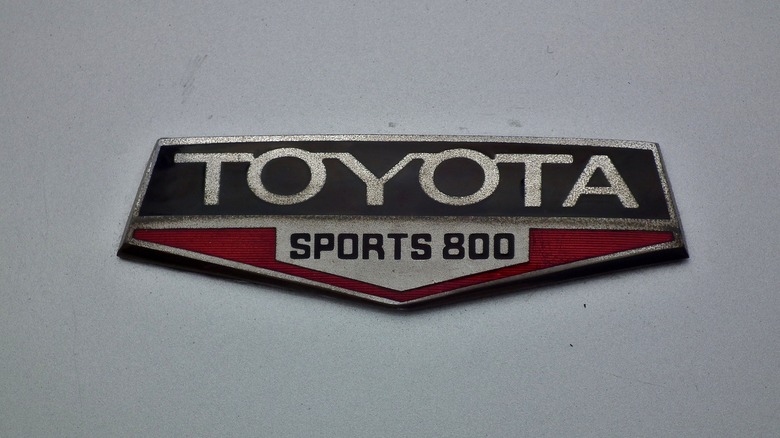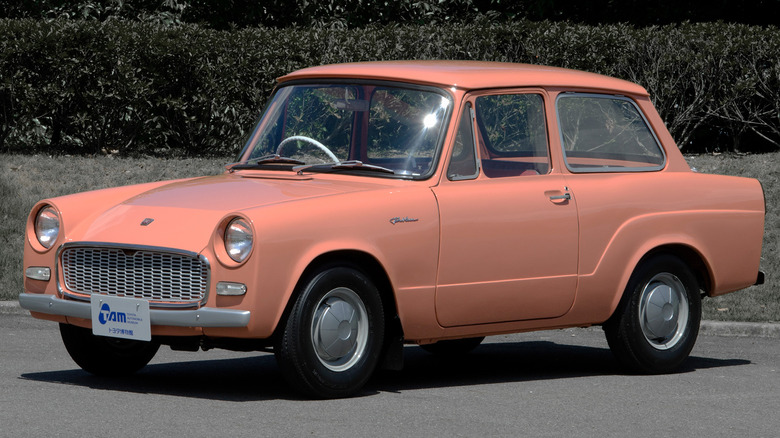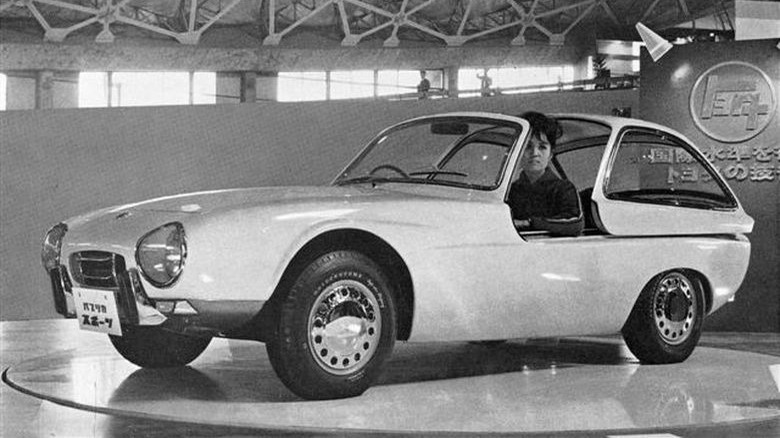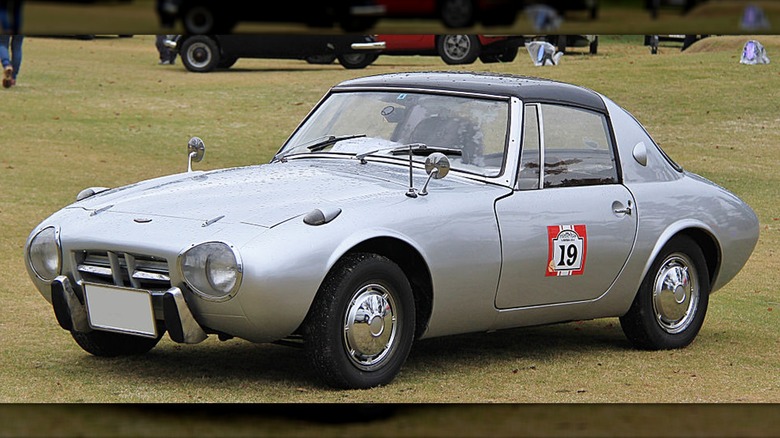The Story Of Toyota's First Sports Car And Its Lasting Legacy
Toyota started selling cars in 1958 with the Toyopet Crown sedan and, believe it or not, the Land Cruiser. During that first year of production, just 288 automobiles were sold: 287 Toyopets and one single Land Cruiser. In the early '60s, just as Japan's economy was flourishing post World War II, with the gross domestic product (GDP) growing at 10% a year, its automakers began experimenting with the new rage of "sports cars."
Datsun unleashed the Fairlady 1200 Roadster in 1961, Honda rolled out the S500 in 1963, and Toyota's first — the Sport 800, part of our 10 best sports cars ever made by the Japanese company — hit the road in 1965. But the sleek-looking auto with a detachable roof started as anything but sporty.
The Sport 800 sprang from the loins of the P10-series Publica, which, in comparison, was a drab proletarian vehicle built for the masses because that's precisely what it was meant to be. In 1955, Japan's Ministry of International Trade and Industry (MITI) put out an RFP (request for proposal) to the country's automakers to design an affordable, reliable "national car."
Toyota found its lead engineer in Tatsuo Hasegawa, who would eventually create the Corolla and Celica. The thing was, Hasegawa was an airplane guy, not a car guy, having earned an aeronautical engineering degree in 1939 from Tokyo Imperial University and worked for Tachikawa Aircraft until the war ended. Toyota promptly hired him in '46, and he diligently worked his way up the proverbial ladder.
[Featured image by sv1ambo via Wikimedia Commons | Cropped and scaled | CC BY-SA 2.0]
The no-frills Publica was made for the masses
Toyota bosses at the time wanted a front-wheel drive car, but the feature was considered too expensive and didn't fit MITI's "cheap and affordable" requirement. Several of MITI's other conditions were much stricter. The car couldn't go faster than 62 miles per hour, had to weigh less than 880 pounds, wouldn't need significant repairs before the odometer ticked over 62,000, and had to get about 72 miles per gallon. The company would receive an additional tax break if it managed to keep the engine under 500cc.
Such harsh constraints forced Tatsuo Hasegawa's team to develop the "no-frills" Publica, a two-door rear-wheel drive without a heater or a radio. It was powered by a 697cc, 28 hp air-cooled flat-twin mated to a four-speed manual. Though the Publica was successful when it launched in 1961, it was generally perceived as being too basic, especially given that consumers wanted more than just a "no-frills" car that would get them from point A to point B.
Toyota wanted to provide the public with a vehicle that was bold, sleek, and almost naughty by nature. This is where fate starts to weave its way into our story. But first, we must jump back to 1937, when competitor Nissan hired a designer named Shozo Sato, a stubborn man who was unwilling to make concessions when it came to design changes, and he wasn't subtle about it. Sato was also a heavy chain smoker and suffered from poor health because of his addiction.
The Publica Sports was anything but ordinary
By the late '50s, Shozo Sato was prone to taking leaves of absence because he was so ill. There's even some ambiguity as to whether he was still employed by Nissan when, in early 1960, he was "loaned" to Toyota. Whatever the case, Toyota tapped Sato to design that bold, sleek sports car, a man who, in many ways, was considered by conventional Japanese standards to indeed be naughty by nature. In 1962, Toyota's Publica Sports concept car was revealed at the Tokyo Motor Show.
It had the Publica's same unexceptional 690cc 28 hp front-engine and rear-wheel drive layout but looked wildly different. Instead of a typical two-door roaster, Sato and Tatsuo Hasegawa (an airplane guy, if you recall) and their team ditched the doors entirely and went with a mostly glass canopy that, from the A-pillar backward, slid on rails. The driver and passenger had to step up and over the car's sides to sit inside, much like one would do to get into the cockpit of a fighter plane.
It certainly got people's attention and was so well received that Toyota gave the green light to move ahead with a full-production model. Unfortunately, Sato would have very little input on the project over its development and final production cycle over the next three years. By the time it was made available for sale in April 1965, some changes had occurred, not the least of which it was now called the Sports 800.
The Sports 800 won hearts and minds, if not Toyota's bottom line
The sliding glass canopy — impractical as a production feature, mainly because it was too heavy — had evolved into a Targa-style roof with a removable panel that could be stored in the trunk. The 800 came out several months before Porsche's 911 Targa, officially making it the first production car with such a thing.
It kept the Publica's double-wishbone front suspension and rear leaf springs, along with the design of the body, floor, and chassis. However, thinner-gauge, lighter-weight steel was used to make the unibody. The body panels and Targa-roof were built using almost paper-thin aluminum with virtually zero rust resistance. The mild-mannered 690cc air-cooled flat-twin cylinder engine from the Publica was bored out to 790cc. Twin carburetors were added, and compression was boosted to 45 horsepower with a top speed of around 96 mph. Every effort was made to keep it light; in the end, it weighed only 1,280 pounds.
With a price of just $1,653, it sold well to the younger generation but moved only 1,235 units in 1965, and sales bottomed out in 1969 with just 215. Thanks to its dependability and gas mileage, though, it excelled at endurance racing and won the 1965 All-Japan Clubman Championship Race, the '66 Suzuka 500km Endurance Race, and took third (behind a pair of Toyota's 2000GTs) at the Fuji 24-hour race in 1967.
There may have never been the successful lineage we know today — be it the rare and iconic 2000GT, Supra, Celica, MR2, and others — without the Sports 800. One could even call it the Godfather of Toyota's sports car empire.
[Featured image by TTTNIS via Wikimedia Commons| Scaled | CC BY-SA 1.0]



